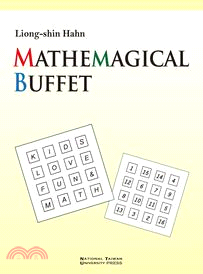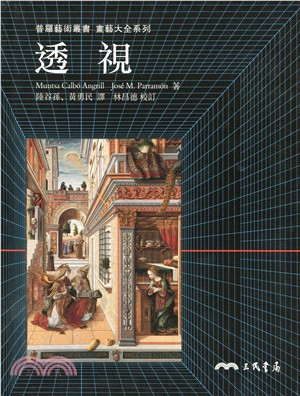Mathemagical Buffet
商品資訊
系列名:精通系列
ISBN13:9789860355109
出版社:臺大出版中心
作者:Liong-shin Hahn
出版日:2013/01/09
裝訂/頁數:平裝/248頁
規格:23cm*17cm (高/寬)
商品簡介
The chapters are independent and can be read in any order. Everyone who enjoys elementary mathematics will truly delight in the following gems:
l. Pythagorean Triples via Geometry
l.New proofs of Generalizations of the Theorems of Ptolemy and Simson
l. Mind Reading Tricks, Ladder Lotteries, Mazes, Lattice Points, Round Robin Competitions, An Elementary Fixed Point Theorems and More
l.Simple proofs of the lovely Theorems of Pick and of Jung
l.The Constructibility of a Regular 17-gon
l.Open Problems on Egyptian Fractions and on Primes
Moreover, the reader is gently encouraged to participate actively by responding to a line of questions that are thoughtfully sprinkled throughout the developments of the expositions.
作者簡介
序
Throughout my many years of teaching at the university level, I frequently enjoyed giving stimulating little talks to secondary-school students (in the U.S. and Taiwan). This book contains detailed accounts of these talks. Because each topic is aimed at a particular grade level, chapters are independent and may be read in any order.
It is unlikely that more than a small fraction of our students will actually use mathematics in their careers. Therefore, we would do well to foster healthy attitudes and worthwhile habits of mind while they are in our care. In particular, I stress
(a) an appreciation of the beauty of mathematics,
(b) acquiring the habit of deep thinking,
(c) the ability to reason logically.
For this purpose, I can't think of a better choice than the revival of Euclidean geometry in our secondary school curriculum. Euclidean geometry contains a wealth of not only wonderful theorems for students to enjoy the beauty of mathematics, but also intriguing and challenging problems to lure students into deep thinking and explorations; not to mention that it provides a fertile ground for training in logical reasoning. In fact, I have heard many people in my generation and earlier who claimed that they enjoyed Euclidean geometry immensely, even though they were not good at algebra. As Albert Einstein said, "If Euclid failed to kindle your youthful enthusiasm, then you were not born to be a scientific thinker."
Mathematics books are not to be "read". They should be worked through with pencil and paper. Looking back on my own experience, I learned mathematics not by reading books, nor by attending lectures. I learned mathematics mainly by solving (or trying to solve) challenging problems; by trying to explore what happens when part of the assumption of the theorem is altered or deleted; by trying to find what it means in simple particular cases; by investigating the converse. In short, by playing around with problems. Furthermore, my experience convinces me that the crux of a great theorem lies often in a simple concrete special case. Consequently, in teaching, I try to emphasize the important particular cases rather than the most general case. And I try my best to expose the motivation behind each move; at the minimum, I try to avoid presenting solutions and proofs as beautiful but "static" finished artifacts.
I believe that mathematics textbooks should emphasize ideas; they should not be mere collections of the facts. My teaching motto is: "Don't try to teach everything. Always leave something for students to explore." Hence I tell my students, "I do the easy part and you do the hard part." Consequently, I am allergic to overweight textbooks trying to include everything. Does anyone really believe students are interested in reading 5-pound, 800-page textbooks with most of the pages filled with repetitions of simple routine drills, ad nauseam? I get the impression that authors of overweight textbooks are more concerned with encyclopedic coverage of topics at the expense of discussing how topics relate to each other. Consequently, students think that mathematics is just a collection of facts, facts to be remembered in order to pass multiple-choice tests. How tragic it is to starve millions of eager young minds by depriving them of being exposed to the beauty and excitement of mathematics!
This book goes against the current trend. I try to present something intriguing that does not yield to well-worn standard approaches, something that involves a spark of ingenuity. The book is now presented to be judged by readers. I cherish the hope that you will enjoy the feast in my Mathemagical Buffet.
L.-s. Hahn
目次
1 Sums of Consecutive Integers 1
2 Galilean Ratios 7
3 The Pythagorean Theorem 11
3.1 Proofs 11
3.2 A Puzzle 17
3.3 Pythagorean Triples 18
3.4 Generalizations of the Pythagorean Theorem 20
4 Japanese Temple Mathematics 25
4.1 Problems 25
4.2 Solutions 27
5 Mind Reading Tricks 41
5.1 Trick 1 41
5.2 Trick 2 43
6 Magic Squares 47
6.1 New Year Puzzle 2010 47
6.2 Magic Squares 49
7 Fun with Areas 53
7.1 Two Theorems of Newton 53
7.2 A Charming Construction Problem 59
7.3 A Generalization of the Simson Theorem 62
8 The Tower of Hanoi 67
9 Ladder Lotteries 71
10 Round Robin Competitions 79
11 Egyptian Fractions 83
12 The Ptolemy Theorem 89
12.1 The Ptolemy Theorem 89
12.2 Applications 90
12.3 A Generalization of the Ptolemy Theorem 92
13 Convexity 95
13.1 Introduction 95
13.2 The Theorems of Jung and Helly 96
14 The Seven Bridges of Konigberg 99
14.1 Unicursal Figures 99
14.2 Mazes 101
15 The Euler Formula 105
15.1 The Euler Formula 105
15.2 Regular Polyhedra108
16 The Sperner Lemma 111
16.1 The Sperner Lemma 111
16.2 The Brouwer Fixed Point Theorem 117
16.3 An Elementary Fixed Point Theorem 119
17 Lattice Points 125
17.1 The Pick Theorem 125
17.2 Lattice Equilateral Triangle 133
17.3 Lattice Equiangular Polygons 135
17.4 Lattice Regular Polygons 138
18 The Sums of Special Series 139
18.1 The Sum of the Powers 139
18.2 The Binomial Coe cients 141
18.3 Faulhaber Polynomials 143
18.4 The Sums of the Reciprocals of Sp(n) 150
18.5 The Sums of Trigonometric Functions 153
19 The Morley Theorem 157
20 Angle Trisection 163
20.1 Rules of Engagement 163
20.2 The Trisection Equation 167
20.3 Computations by Straightedge and Compass 169
20.4 Fields and their Extensions 172
20.5 Impossibility Proofs 176
20.6 Bending of the Rules 180
20.7 Regular Polygons 181
20.8 Regular 17-gon 185
21 Conics 195
22 Primes 203
22.1 Number of Primes 203
22.2 An Open Problem 205
23 Gaussian Integers 209
23.1 Gaussian Primes 209
23.2 An Application to Real Primes 216
24 Calculus with Complex Numbers 219
Appendix Determinants 223
A.1 Genesis 223
A.2 Properties 232
A.3 The Laplace Expansion Theorem 235
書摘/試閱
From 17th century to early 20th century, people of various walks in Japan offered their mathematical discoveries on wooden tablets to shrines and temples. Most of the time, it was done for pure enjoyment or to challenge others (but certainly not for college entrance or job promotion). Majority of them were in geometry. To me that is a strong indication that geometry had (and still has) popular appeal to the general public. Thus I find it very tragic that geometry is being de-emphasized in school mathematics nowadays.
--p. 25
Suppose we have 12 table tennis players. Instead of a tournament, during which many pairs of players do not have a chance for a match, the organizer decides on a round robin competition so that every pair of players has a chance to meet. He wants every player to have one match every day so that six matches are played every day. Naturally, it takes eleven days to play all the matches, because each one has 11 opponents. How should he arrange the matches? He is concerned that if not well-planned, some players might find the opponents they needed unavailable in the final days, forcing them to wait and requiring extra days for the competition.
--p.79
Because of the fact that there exist angles (such as 60° angle) that cannot be trisected (using compass and straightedge finitely many times), mathematicians tended to shy away from problems involving trisections of angles. Perhaps that is why the following dandy theorem was discovered only in 1904 by the British geometer Frank Morley (1860 - 1937). The idea in our proof was essentially the one shown to me by Professor John H. Conway of Princeton University, when I (as the director of the New Mexico
Mathematics Contest) invited him to give a talk to the Contest finalists in February 1999.
--p.157
主題書展
更多書展今日66折
您曾經瀏覽過的商品
購物須知
為了保護您的權益,「三民網路書店」提供會員七日商品鑑賞期(收到商品為起始日)。
若要辦理退貨,請在商品鑑賞期內寄回,且商品必須是全新狀態與完整包裝(商品、附件、發票、隨貨贈品等)否則恕不接受退貨。










































